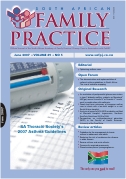Good short-term outcome of kangaroo mother care in low birth weight infants in a rural South African hospital
Keywords:
Kangaroo mother care, pre-term infants, weight gain, jaundice
Abstract
Objective: The aim of the study was to determine the outcome of kangaroo mother care (KMC) in low birth weight infants at a community hospital. Methods: This descriptive study included 87 mothers and their low birth weight infants who were in a stable condition and eligible for KMC at Dr JS Moroka Hospital, Thaba Nchu. The infants were assessed four times: at birth, twice during hospitalisation, and a week after discharge. Infants received breast milk exclusively. Results: Regarding the mothers’ obstetric history (n=87), gravidity ranged from 1 to 7 (median 3), with a 43% incidence of miscarriage. The median birth weight of the infants (n=87) was 1.5 kg (first assessment), the discharge weight (third assessment) was 1.8 kg, and a week after discharge (fourth assessment) it was 2.2 kg. Initially the infants lost weight significantly from birth to the second assessment (95% CI for median decrease [-0.02; -0.01]), but significantly gained weight from the second to the third (95% CI for median decrease [0.27; 0.33]) and from the third to the fourth assessment (95% CI for median decrease [0.32; 0.45]). Approximately half (49%) of the infants had developed jaundice by the time of second assessment. These babies had a significantly lower birth weight [0.12;0.30]. Conclusion: Our findings confirm that infants with a low birth weight treated with KMC can have a good growth pattern, and exclusive breast milk is sufficient to guarantee such growth. Kangaroo mother care is a safe method for stable infants with a low birth weight in a community hospital.
Published
2007-06-01
Issue
Section
Original Research
By submitting manuscripts to SAFP, authors of original articles are assigning copyright to the South African Academy of Family Physicians. Copyright of review articles are assigned to the Publisher, Medpharm Publications (Pty) Ltd, unless otherwise specified. Authors may use their own work after publication without written permission, provided they acknowledge the original source. Individuals and academic institutions may freely copy and distribute articles published in SAFP for educational and research purposes without obtaining permission.

